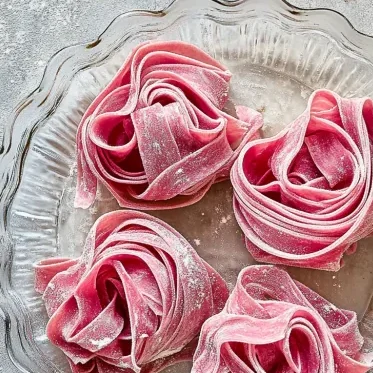What the heck is this?
This isn’t just pasta—it’s edible art. Homemade beet pasta dough takes your average pasta night and cranks it up to eleven. It’s naturally dyed a vibrant magenta from roasted or steamed beets, but don’t worry—it doesn’t taste like you’re eating a salad. The beet flavor is subtle, slightly earthy, and plays beautifully with creamy sauces, nutty cheeses, and bright lemony finishes. Whether you’re rolling it into silky fettuccine or stuffing it into ravioli, this dough will make you feel like a pasta sorcerer.
Why You’ll Love This Recipe
This beet pasta dough isn’t just pretty—it’s also tender, pliable, and easy to work with once you get the hang of it. Plus, you’re sneaking in veggies without sacrificing flavor (kids might not even notice). It’s a fun weekend project that results in a dish impressive enough for date night or a dinner party, but chill enough for a cozy night in. And the color? Instagram-worthy without even trying.
The Good Stuff You’ll Need
- 1 medium beet, roasted or steamed (about 100–120g cooked weight)
- 2 large eggs
- 1 tbsp olive oil
- 2 cups (250g) all-purpose flour (plus more for dusting)
- ½ tsp salt
- Optional: ¼ cup semolina flour (for texture and easier rolling)

Let’s Do This
1. Prep your beet: Roast or steam your beet until fork-tender (about 45–60 minutes to roast at 400°F, or 30 minutes to steam). Let it cool, then peel and puree in a food processor until completely smooth. You want about ½ cup of beet puree.
2. Make a well: On a clean work surface, heap your flour (and semolina if using) into a mound. Mix in the salt, then create a wide well in the center. Add the beet puree, eggs, and olive oil to the well.
3. Mix and knead: Use a fork to gradually incorporate flour into the wet mixture, then switch to your hands and knead until you get a smooth, elastic dough. It should take about 8–10 minutes of solid kneading. If it’s too sticky, sprinkle in a little more flour; too dry, add a teaspoon of water at a time.
4. Rest: Wrap the dough in plastic wrap and let it rest at room temp for at least 30 minutes. This allows the gluten to relax and makes the dough much easier to roll.
5. Roll it out: Cut your rested dough into 2–4 pieces and roll each out with a pasta roller or rolling pin until it’s thin enough to see your hand through (usually setting 5 or 6 on a pasta roller). Dust with flour as needed to keep it from sticking.
6. Shape it: Cut into fettuccine, pappardelle, or sheets for lasagna. You can also use it for ravioli—just make sure to seal edges well since it’s a moister dough than plain pasta.
7. Cook it: Boil in salted water for 2–3 minutes (fresh pasta cooks fast!). Toss with your favorite sauce and serve hot.
Serving Suggestions
This beet pasta loves creamy, cheesy, and lemony partners. Try it with a browned butter-sage sauce, whipped goat cheese and walnuts, a lemon ricotta blend, or even a simple garlic cream sauce with spinach. Want to go fancy? Stuff it with herbed ricotta and serve with a drizzle of balsamic glaze.
Switch It Up
- Use golden beets for a deep yellow-gold hue
- Add a touch of lemon zest or nutmeg to the dough for extra dimension
- Make it vegan by replacing the eggs with 1 flax egg and a few extra tablespoons of olive oil (texture will be softer, but still works)
- Try using half whole wheat flour for a nuttier flavor
Make-Ahead Tips
You can make the dough up to 2 days in advance—just wrap tightly and refrigerate. It also freezes well: shape into pasta, dust with flour, and freeze on a baking sheet before transferring to a bag. Cook straight from frozen—just add a minute or two to the cook time.

Questions People Actually Ask
Will this taste like beets? Barely. It’s more about color and a hint of earthiness. The flavor is subtle and works with a wide range of sauces.
Can I use canned beets? You can, but roasted or steamed fresh beets give the best flavor and texture. If you use canned, make sure they’re not pickled and drain them well.
Why did my dough turn sticky? Beets add moisture, so if your dough feels tacky, just knead in a little more flour.
Can I dry this pasta? You can air-dry cut shapes for a few hours, but it’s best enjoyed fresh or frozen. The color may dull slightly if dried fully.

Homemade Beet Pasta Dough: Bright, Earthy, and Seriously Gorgeous
- Total Time: 1 hour 3 minutes
- Yield: 4 servings 1x
Description
This isn’t just pasta—it’s edible art. Homemade beet pasta dough takes your average pasta night and cranks it up to eleven. It’s naturally dyed a vibrant magenta from roasted or steamed beets, but don’t worry—it doesn’t taste like you’re eating a salad. The beet flavor is subtle, slightly earthy, and plays beautifully with creamy sauces, nutty cheeses, and bright lemony finishes. Whether you’re rolling it into silky fettuccine or stuffing it into ravioli, this dough will make you feel like a pasta sorcerer.
Ingredients
1 medium beet, roasted or steamed (about 100–120g cooked weight)
2 large eggs
1 tbsp olive oil
2 cups (250g) all-purpose flour (plus more for dusting)
½ tsp salt
Optional: ¼ cup semolina flour (for texture and easier rolling)
Instructions
1. Prep your beet: Roast or steam your beet until fork-tender (about 45–60 minutes to roast at 400°F, or 30 minutes to steam). Let it cool, then peel and puree in a food processor until completely smooth. You want about ½ cup of beet puree.
2. Make a well: On a clean work surface, heap your flour (and semolina if using) into a mound. Mix in the salt, then create a wide well in the center. Add the beet puree, eggs, and olive oil to the well.
3. Mix and knead: Use a fork to gradually incorporate flour into the wet mixture, then switch to your hands and knead until you get a smooth, elastic dough. It should take about 8–10 minutes of solid kneading. If it’s too sticky, sprinkle in a little more flour; too dry, add a teaspoon of water at a time.
4. Rest: Wrap the dough in plastic wrap and let it rest at room temp for at least 30 minutes. This allows the gluten to relax and makes the dough much easier to roll.
5. Roll it out: Cut your rested dough into 2–4 pieces and roll each out with a pasta roller or rolling pin until it’s thin enough to see your hand through (usually setting 5 or 6 on a pasta roller). Dust with flour as needed to keep it from sticking.
6. Shape it: Cut into fettuccine, pappardelle, or sheets for lasagna. You can also use it for ravioli—just make sure to seal edges well since it’s a moister dough than plain pasta.
7. Cook it: Boil in salted water for 2–3 minutes (fresh pasta cooks fast!). Toss with your favorite sauce and serve hot.
Notes
Use golden beets for a deep yellow-gold hue
Add a touch of lemon zest or nutmeg to the dough for extra dimension
Make it vegan by replacing the eggs with 1 flax egg and a few extra tablespoons of olive oil (texture will be softer, but still works)
Try using half whole wheat flour for a nuttier flavor
- Prep Time: 1 hour
- Cook Time: 3 minutes
Nutrition
- Calories: ~250 kcal per serving
- Fat: ~4g
- Carbohydrates: ~45g
- Protein: ~9g

